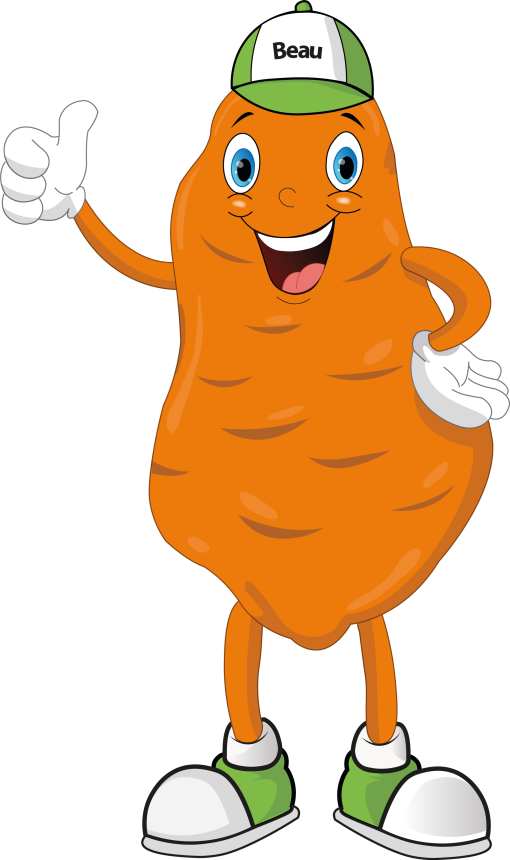Beaubatati & Friends
Cultivation instructions

Cultivation Guide
Congratulations, you have purchased or received a premium product from the Beau Batati range. A sweet potato plant, completely organically grown, with which you can grow your own sweet potatoes. In order to achieve a good result, we would like to give you some tips.
Planting
After purchasing your plants, it is important that they are repotted as soon as possible in the full ground or in a suitable cultivation bag (minimum capacity 50 litres). In the open ground it is preferable to make so-called planting ridges of about 40 cm wide in which to plant the purchased plants. Recommended planting distance is approx. 40 cm centre to centre. Fertilise the soil lightly with compost only if the soil is exceptionally poor, but this is usually not necessary due to the limited need for nitrogen. Remove the purchased plants from their pots and place them in the ground with their complete root ball. After this, wet everything thoroughly once so that the root ball can also connect with the soil around it.

After planting
As soon as the plants are in the full ground, keep the soil moist during the first two weeks so that the plant can quickly develop a good root system. After this period, let the plant look for its water. With excessive watering, a lot of crop will develop but this will be at the expense of the final yield of sweet potatoes. Only if your plants are already somewhat weak at 8.00 in the morning is a sprinkling advisable.
Nutrition
A sweet potato does not consume a lot of nutrients and is only fertilised to a limited extent. In the period 2the In mid-July and August, it may be advisable to give a little extra potash now and again, but in very limited quantities.
Diseases and pests
Just like any other plant outside, it can sometimes happen that lice, thrips, caterpillars or snails use your plant as a host. Until now, nature itself has always solved this neatly and efficiently, and a Spraying with any household or garden remedy is not necessary. Your plants usually grow relatively quietly until the middle of August, but as soon as the humidity outside increases, they become exuberant. After all, the plant is a member of the bindweed family.
Harvesting
At the end of September/beginning of October after about 120 days of growth you can start harvesting your sweet potatoes. First remove the foliage and dig out your sweet potatoes within 48 hours. Make sure that the fruit is bruised as little as possible and, depending on the weather, leave the sweet potatoes to cure for about 5-10 days in the field. It is important that the temperature does not drop below 14 degrees Celsius, as this does not benefit the shelf life of your sweet potatoes.
Nutrition
A sweet potato does not consume a lot of nutrients and is only fertilised to a limited extent. In the period 2the In mid-July and August, it may be advisable to give a little extra potash now and again, but in very limited quantities.
Diseases and pests
Just like any other plant outside, it can sometimes happen that lice, thrips, caterpillars or snails use your plant as a host. Until now, nature itself has always solved this neatly and efficiently, and a Spraying with any household or garden remedy is not necessary. Your plants usually grow relatively quietly until the middle of August, but as soon as the humidity outside increases, they become exuberant. After all, the plant is a member of the bindweed family.
Harvesting
At the end of September/beginning of October after about 120 days of growth you can start harvesting your sweet potatoes. First remove the foliage and dig out your sweet potatoes within 48 hours. Make sure that the fruit is bruised as little as possible and, depending on the weather, leave the sweet potatoes to cure for about 5-10 days in the field. It is important that the temperature does not drop below 14 degrees Celsius, as this does not benefit the shelf life of your sweet potatoes.
The Sweet Potato
The Ipomoea batata, also known as sweet potato, is a plant generally grown for its large, starchy and sweet-tasting tubers. These sweet potatoes come in different varieties, varying in flavour, size and the colour of both the flesh and the skin of the tuber.
When we talk about the sweet potato, we often speak of tubers or sweet potatoes instead of actual potatoes. This is because the sweet potato, although a distant descendant, does not belong to the species group of the common potato. Apart from the fact that they are both starchy fruits that grow under the ground, there are not many similarities. Apart from its deliciously sweet taste, the sweet potato is also much healthier because it contains more important minerals and vitamins.
As mentioned earlier, the sweet potato comes in countless varieties and variations. Some of these varieties are not even cultivated for their tubers but for ornamental purposes. Other varieties are also better off not being eaten by people because they are poisonous.
Beau Batati & Friends are a premium selection of edible sweet potatoes. As can be seen in Beau, Bianca and Boys, the group consists of various types of sweet potato with different characteristics and flavours. The sweet potato has become increasingly popular in the Netherlands in recent years and is used in various types of cuisine. Beau, the orange tuber, will be the most well-known. Boys (Purple) and Bianca (White) are also increasingly used in dishes due to their eccentric taste.
The Sweet Potato
The Ipomoea batata, also known as sweet potato, is a plant generally grown for its large, starchy and sweet-tasting tubers. These sweet potatoes come in different varieties, varying in flavour, size and the colour of both the flesh and the skin of the tuber.
When we talk about the sweet potato, we often speak of tubers or sweet potatoes instead of actual potatoes. This is because the sweet potato, although a distant descendant, does not belong to the species group of the common potato. Apart from the fact that they are both starchy fruits that grow under the ground, there are not many similarities. Apart from its deliciously sweet taste, the sweet potato is also much healthier because it contains more important minerals and vitamins.
As mentioned earlier, the sweet potato comes in countless varieties and variations. Some of these varieties are not even cultivated for their tubers but for ornamental purposes. Other varieties are also better off not being eaten by people because they are poisonous.
Beau Batati & Friends are a premium selection of edible sweet potatoes. As can be seen in Beau, Bianca and Boys, the group consists of various types of sweet potato with different characteristics and flavours. The sweet potato has become increasingly popular in the Netherlands in recent years and is used in various types of cuisine. Beau, the orange tuber, will be the most well-known. Boys (Purple) and Bianca (White) are also increasingly used in dishes due to their eccentric taste.
© VMM B.V. All rights reserved